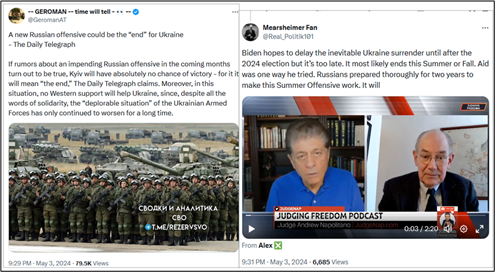Grand Finale of SMO in full swing in Ukraine
The Special Military Operation (SMO), as Russia officially calls the invasion in Ukraine, seems to be culminating in next eight weeks. After the national holidays, celebrated by all Russian citizens in early May, majority of analysts and observers foresee that Big Events, including “Russian Big Arrow Offensive” will take place in the war. However, it’s far from clear, where the Russians will even aim their main effort. It’s important to remember a Russian concept “maskirovka” – a bluff or diversion by which Russian Forces draw attention of the enemy away from the real action. There have been plenty of examples during last two years.
Foreword
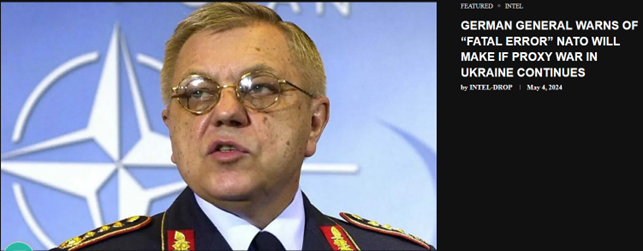
The forces in Western countries behind the prolongation of the Ukrainian war are “fatally” mistaken in their assumption that Kiev could benefit in some way with it being dragged out longer, warns German general Harald Kujat, former chairman of the NATO Military Committee. However, it is evident that Washington and Kiev are planning a prolonged campaign of pressure against Moscow.
“It would be a fatal error to believe that Ukraine’s prospects will improve the longer the war continues. On the contrary, the catastrophic consequences of this error can only be avoided if it is possible to prevent a military defeat through an early cessation of hostilities and [starting] peace negotiations between the two belligerent countries,” said Kujat in an interview with the German magazine Overton Magazin.
“Es ist ein fataler Irrtum zu glauben, dass sich die Zukunftsaussichten der Ukraine verbessern, je länger der Krieg dauert“.
It is worth keeping these wise words of General Kujat in mind, when considering the situation in Ukraine now.
Situation and progress on frontlines and rear areas, late April – early May
Since the start of this year 2024, the Russian Armed Forces have carried out group strikes by sea- and air-launched high-precision weapons, including Kinzhal and Zircon hypersonic missiles, as well as unmanned aerial vehicles, targeting Ukrainian energy industry facilities, military industrial enterprises, air defense systems, arsenals, fuel bases, ammo depots, temporary deployment areas of Ukrainian units and foreign mercenaries.
Approx. number of group strikes per a month (please note that every group strike includes dozens of sorties): January 140, February 120, March 190, April 180, totaling up to 630 group strikes (several thousand sorties).
According to official data provided by Russian Ministry of Defense during the first four months of this year 2024, the average troops losses of Armed Forces of Ukraine (AFU) are per day about 1,000 servicemen and per a month 30,000 servicemen. These calculations cover only proved losses on the frontlines, not the losses inflected by group strikes in rear areas.
In my statistics here below, estimated losses per a group strike are about 60 servicemen, which figure is based on many case studies. This calculation gives the total AFU losses of Russian group strikes up to nearly 40,000 servicemen in January-April 2024. When totaling frontline and rear area losses of AFU, the result shows a staggering amount of 160,000 servicemen in the four first months of 2024. No wonder, AFU suffers the lack of manpower.
This gives the sound base to estimate that, since the start of the war (February 24, 2022), the total number of AFU losses is something like this: over 600,000 KIA, about 1,5 million WIA and MIA. The satellite images covering the whole area of Ukraine confirm the number of newly made graves exceeds 500,000.
Realistic estimates (based on Mediazona, BBC and data of several international military analysts) give the size range of Russian troops losses: about 80,000 KIA, 140,000 WIA and MIA.
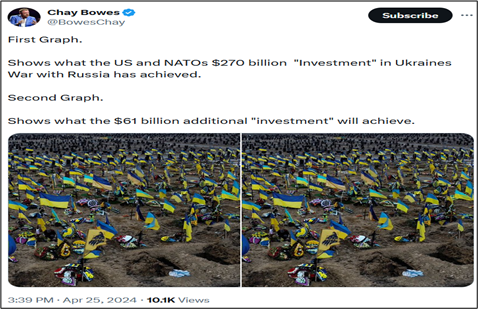
Ukrainian acute problem of manpower
Ukrainian Forces (AFU) suffers an acute lack of recruiters, as seen in those tweets below. Now Zelensky has asked neighbor countries to send back all the military-aged men, who escaped from Ukraine during last two years.
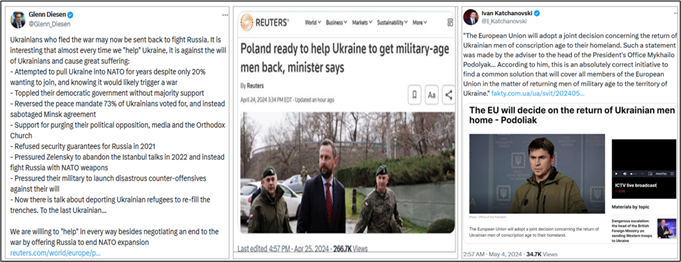
The AFU are experiencing an acute shortage of manpower right now, the former commander of the Polish Land Forces, General Waldemar Skrzypczak told. “The key problem for Ukraine is who rather than what to fight with. The army is short of between 150,000 and 200,000 soldiers at the front,” the retired Polish general noted.
Earlier, Lieutenant General Yury Sodol, commander of the Ukrainian army’s joint forces, said that Ukrainian troops in the combat zone had from seven to ten times less men than Russia on the battlefield. In early April, the Ukrainian parliament adopted a law passing stricter rules for mobilization. The law has already caused a number of scandals and outrage on social media in recent months, as it will allow the additional recruitment of several hundred thousand Ukrainians, according to estimates from the Ukrainian media.
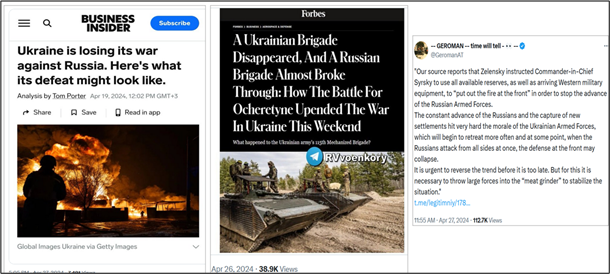
“Bad news for Ukraine”: exhausted brigades of the AFU are abandoning their positions, refusing to fight, surrendering etc. (e.g. the 47th brigade, the 115th brigade, the 67th brigade, the 68th mechanized infantry brigade). “Kyiv cannot afford to lose as many as 2 brigades right now – and cannot afford to continue to overstretch its best brigades. Billions of dollars of fresh weapons are on the way, but these weapons are useless unless there are enough deployed, organized and well-rested units to use it,” American magazine Forbes concludes.
In contrast to manpower problems in the AFU, Russia has plenty of well-trained, fresh battle troops ready take part in action where ever on the frontline. Nowadays Russia has organized the Russian Forces in the Special Military Operation in the following way: Battlegroup West, Battlegroup South, Battlegroup Center, Battlegroup East, Battlegroup Dnepr, Air Force and air defenses. Russia is today utilizing system of “contract serviceman”, which are recruited about 30,000 per a month. According to the law, “conscription soldiers” are not allowed to be used in the combat operations. All this means that the clear majority of Russian army are professional, well-trained and well-equipped pros.
Moreover, as Bloomberg stated, plenty of previously escaped Russian are returning!
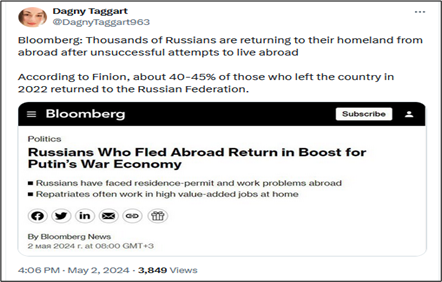
Here below some interesting sources of information regarding recent military events in Ukraine.
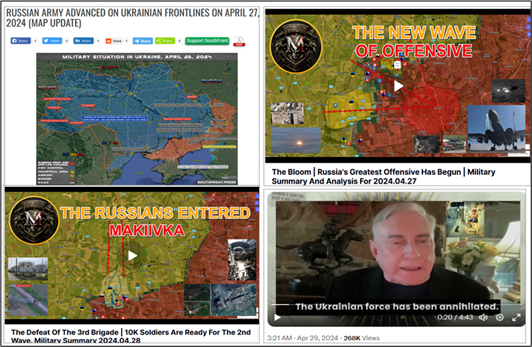
The Bloom | Russia’s Greatest Offensive Has Begun | Military Summary And Analysis For 2024.04.27
The Defeat Of The 3rd Brigade | 10K Soldiers Are Ready For The 2nd Wave. Military Summary 2024.04.28
There’s NOTHING Left!” 600,000 Ukrainians DEAD! “It’s OVER For Ukraine & Zelensky Will Be GONE Within 60 Days.” Col. Douglas MacGregor, April 29, 2024
Russia has continued hard air strikes around Ukraine, particularly devastating strikes have been in Kharkiv and Odessa regions. Dozens of western mercenaries and NATO-officers have been killed.
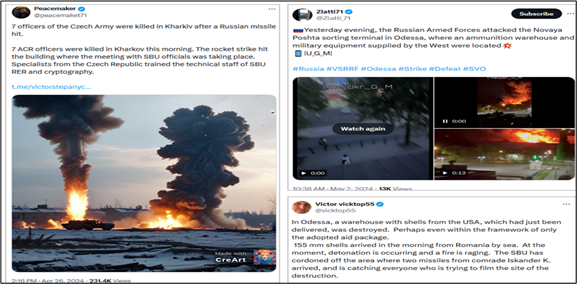
NATO’s growing and widening involvement in Ukraine
I have studied and commented this topic frequently in my recent articles like April 19, April 1, March 23 and March 10.
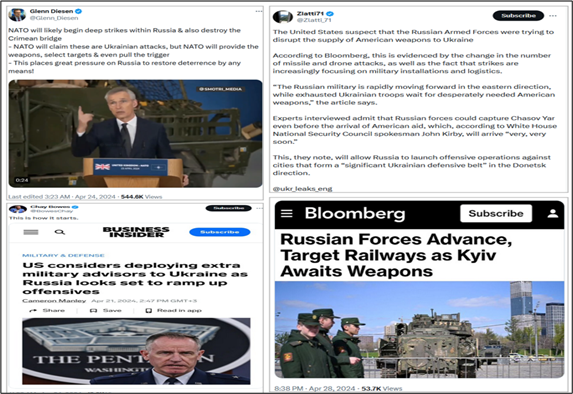
Actions carried by NATO forces
NATO concentrates forces on the eastern flank. On April 23, British Prime Minister Sunak, at a press conference with Polish Prime Minister Tusk, announced the transfer of British Air Force Eurofighter Typhoon fighters to Poland in 2025, as well as 16 thousand military personnel. The British Prime Minister also said that the country will increase defense spending to 2.5% of GDP by 2030 and will begin the transition of the military industry to a “military footing.”
Previously, it was reported on the build-up of NATO battle groups in the Baltic states (the creation in Lithuania of the 45th tank brigade of the German Armed Forces, numbering 4.8 thousand military personnel), Poland (5 thousand Polish and German soldiers) and Romania (4 thousand military personnel of the French Armed Forces).
Ukraine has begun using longer-range ballistic missiles (ATACMS) against Russia that were secretly provided by the US, American officials have confirmed. The weapons were sent as part of a previous US support package and arrived this month. Officials said they were not announced publicly to maintain Ukraine’s “operational security”. They have already been used at least once to strike Russian targets in Crimea. Further US ATACMS and other aid is now heading to Kyiv. So far (May 4), about 30 of those ATACMS, mainly targeted on Crimea, have been shot down by the Russian air defense.
No doubt, the purpose is to strike strategic targets deep in Russian rear areas. There is also another escalating feature in these strikes, the operative teams of launching these missiles are mainly set up of American technical and military persons, who also make the final decision what to target and trigger the missile.
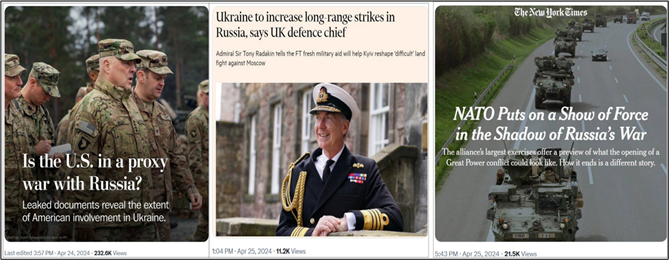
The NATO exercises this spring are against Russia, the commander of US ground forces in Europe told The New York Times. According to General Darryl Williams, in the past such exercises did not name the enemy – there was only a fictional opponent. “We now, in this year, are actually fighting an exercise against the Russians. We fight against our potential adversary,” he noted. According to the publication, the alliance’s spring training will be the largest since the Cold War. The exercises are also a preview of what the opening of a great power conflict might look like.
The idea that NATO can continue to send ever-more powerful and long-range weapons to Ukraine without any retaliation from Russia is premised on the dangerous self-delusion that NATO is not a participant in the conflict. But if we accept that this is also a NATO War, then it is obvious that Russia will eventually feel compelled to retaliate against NATO to restore deterrence, which could trigger a nuclear war.
More troops deployed by NATO as a block and by western countries
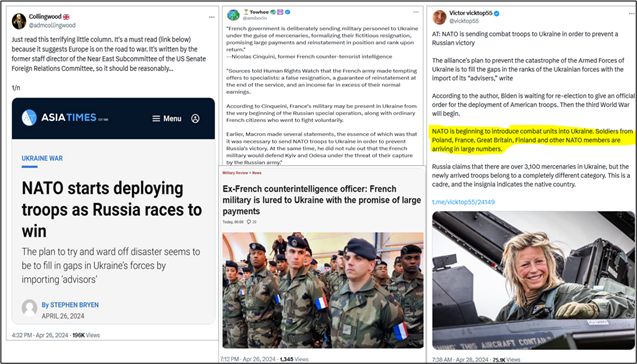
NATO starts deploying troops as Russia races to win
Asia Times, article by Stephen Bryen April 26, 2024
Stephen Bryen served as staff director of the Near East Subcommittee of the Senate Foreign Relations Committee and as a deputy undersecretary of defense for policy.
NATO is starting to deploy combat troops to Ukraine. Soldiers from Poland, France, the UK, Finland and other NATO members are arriving in larger numbers. Although Russia says there are over 3,100 mercenaries in Ukraine, these newly arriving troops are not mercenaries. They are in uniform, home country proclaimed via insignia. They mostly are concentrated in the western part of the country, although in some cases they are close to the actual fighting in the east. NATO is putting out the word these are not combat soldiers but are in Ukraine to operate sophisticated western hardware. But if they are firing at the Russians the only proper way to interpret their presence is that they are playing an active part in the shooting war. More or less, this is the same pattern that the US used when it sent “advisors” to Vietnam. In fact, they were US Special Forces who engaged in combat.
France sends combat troops to Ukraine battlefront
Asia Times, article by Stephen Bryen May 4, 2024
Will the deployment of a Foreign Legion unit commanded by French officers trigger a wider European war? France has sent its first troops officially to Ukraine. They have been deployed in support of the Ukrainian 54th Independent Mechanized Brigade in Slavyansk. The French soldiers are drawn from France’s 3rd Infantry Regiment, which is one of the main elements of France’s Foreign Legion (Légion étrangère).
Rumors and speculations are getting more and more frequent that NATO troops deployment in Ukraine are really going. Now even those states, which likely send their troops in the first batch, have been named: Poland, France, the UK, Baltic states and Finland. The “taboo” about Europe sending troops to Ukraine “has been broken”. Proposing that would be “inconceivable” a few months ago, but French President Emmanuel Macron paved the way to bringing this scenario to the table when he said, on February 26, that deploying European forces to the Slavic country should not be “ruled out”.
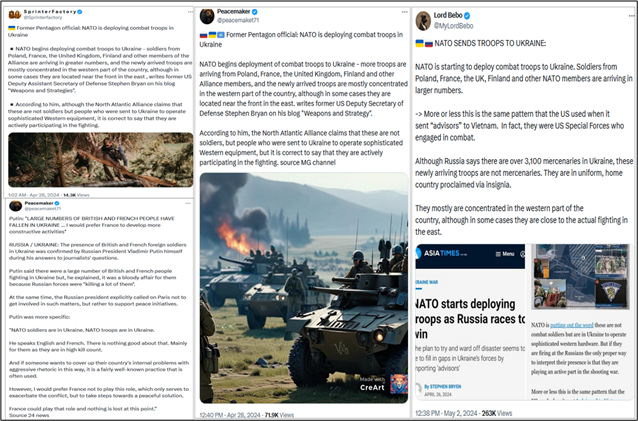
Macron’s bellicose rhetoric was, at first, immediately countered by other NATO leaders, such as German Chancellor Olaf Scholz, British Prime Minister Rishi Sunak and others, as well as, across the Atlantic, US President John Biden. But the tide could be turning: thus far, the Finnish defense minister and the Polish foreign minister have echoed Macron’s call by suggesting their forces could be deployed to Ukraine too.
In the recent article of Foreign Affairs (link below), a new view was presented by three well-known authors, instead of NATO deployment some European countries as separately should send troops to Ukraine. By this operation, the West could “avoid NATO’s Article 5” to be executed.
Europe—but Not NATO—Should Send Troops to Ukraine
To Halt Russia’s Advance, Kyiv Needs More Boots on the Ground
Foreign Affairs, an article by Alex Crowther, Jahara Matisek, and Phillips P. O’Brien
April 22, 2024
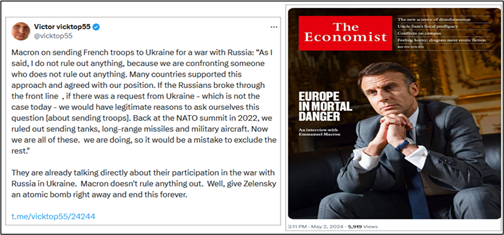
While President Macron is presenting his ideas to launch a French invasion, Florian Philippot, leader of the French political party Les Patriotes, has demanded France’s President Macron drop plans to send troops to Ukraine. “Stop making irresponsible statements that can lead to the worst. No troops, no weapons and not a single euro for Ukraine. Enough! We need peace!” Philippot wrote on the X social media platform. The French president said earlier in an interview with The Economist that sending troops to Ukraine could be considered based on Kiev’s request if Russian forces broke through the front lines.
Way forward: The US has taken in use “Plan B”
It appears that the more difficult the military situation is getting, the more delusional and utopian statements Zelensky is giving. April 28, Zelensky said being negotiating with Washington military, financial and other support volumes for the next ten years. “Today, our teams – of Ukraine and the United States – are working on a bilateral agreement on security. They are already working on the concrete wording. Discussing the concrete basis of our security, our cooperation. According to Zelensky, Kiev wants this agreement with the United States to be “the strongest” one among similar documents it has already signed or is planning to sign with other European allies.

More information about this theme is also available in the article by Finian Cunningham.
The United States-Ukraine security pact is lipstick on a bloody defeat for NATO
Strategic Culture, Article by Finian Cunningham, May 2, 2024
The security pact with Ukraine is a cosmetic gain to conceal what is in reality a shameful defeat to Russia. The United States and Ukraine are moving toward signing a 10-year bilateral security pact. But former Pentagon analyst David Pyne sees it as a sign that Washington realizes Russia is near to outright victory in the conflict.
It appears that now, with this latest aid package, the Biden administration has finally changed its strategy in the war in Ukraine. The Washington Biden team has abandoned any hope of the Ukrainian winning the war and thus has adopted a different strategy altogether.
The key features of the new strategy (Plan B):
- Strategy of Denial: a defensive approach designed to stop an adversary from achieving its goals; in other words, the aim is to prolong the conflict for as long as possible to prevent Russia from achieving a clear victory.
- Increase and intensify asymmetrical attacks on vital infrastructure and civilian areas inside Russian territory in order to inflict as much damage on Russian targets as possible.
Any concern for the Ukrainian people or the future viability of the Ukrainian state, have not been factored in to Washington’s cynical calculation. What matters is preventing a Russian victory and inflicting as much pain on Russia as possible. Those are the primary objectives. In fact, the UK warlords have already confirmed what is said here.
Check out the statements of UK defense chief, Admiral Sir Tony Radakin, telling Financial Times that the West’s new infusion of military aid will help Ukraine increase its long-range strikes on Russian territory. Ukraine is set to increase long-range attacks inside Russia as an influx of western military aid aims to help Kyiv shape the war “in much stronger ways”, the head of the UK military has said.
When considering the allocation of resources provided under the new “National Security Supplemental” that Biden signed into law about the week ago, there are some interesting details. The bill provides $61 billion for Ukraine, of which a mere $13 billion will be spent on weapons and weapons systems. Keep in mind, the US and NATO allies have already spent more than $200 billion funding the war in Ukraine and the Ukrainians are losing. How is another $13 billion supposed to make a difference? Though $61 billion is a massive amount of money, it is not at all big enough to defeat Russia.
It won’t, nor is it intended to. The real purpose of the money is to prevent a clear Russian victory by launching random attacks on critical infrastructure and civilian areas in Russia. Once you understand that the basic operational plan has changed, developments on the ground begin to make sense. The goal is to antagonize a geopolitical rival not to win a war.
It’s worth noting, that most of Ukraine’s best-trained combat units have already been obliterated. That has forced the Zelensky regime to abduct men off the streets of Kiev and send them into battle with just two-weeks training, which is why casualties are so high. These men are simply being sacrificed so that Washington can continue to launch its drone attacks on Russian oil facilities or conduct airstrikes on the Kerch Bridge.
Russia currently enjoys “military superiority, if not outright supremacy, along the entire line of contact, not just on the front lines but extending well into the rear areas of the Ukrainian defense areas. The American people who foolishly believe that the new supplemental aid package will help to expel the “evil” Russians from Ukraine are living in the delusional bubble. No one who follows events on the ground thinks Ukraine has any chance of beating a well-equipped Russian Army.
“$61 billion will not change the outcome of this war,” Nicolai Petro, Professor of Political Science at the University of Rhodes said, “That would require five to seven times that amount, or $350-400 billion. But even if the money was sufficient, it would not provide Ukraine with the weapons it needs because the weapons are not available”.
Even if the West could provide Ukraine with the weapons on time, the “big problem for Ukraine is not the provision of weapons but the “manpower issue.” Ukraine’s losses on the battlefield, to death and injury, have left Ukraine with a bigger manpower problem than artillery problem…. even if the U.S. gave Ukraine all the weapons it needed, they “don’t have the men to use them.”
Assessments and statements by some well-known experts
On April 27, “Ukraine is nearing a disaster. There will be negotiations, but Kiev will simply sign whatever Moscow demands” Dominique Delavard – General of the French Army, shared his vision of the situation in Ukraine. The French military officer believes that today the conflict is developing in Russia’s favor: Ukraine and its Western allies are getting weaker while Moscow is strengthening its military capabilities to organize a new large-scale offensive.
“I think Ukraine is gradually moving towards a disaster. It is retreating everywhere. The frontline is not frozen. I think the Russians are waiting for the right geopolitical moment to organize a large-scale offensive. In my opinion, by the end of the year Ukraine will lose a lot, if not disappear altogether. But the Russians will not move too quickly, they want to finish the job so that the West is plunged into even greater economic problems.
Here below, are available assessments by Garland Nixon, Andrei Martyanov, Judge Napolitano Douglas MacGregor and John Mearsheimer.
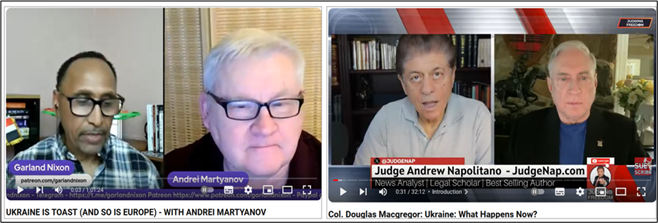
UKRAINE IS TOAST (AND SO IS EUROPE) – WITH ANDREI MARTYANOV
Video by Garland Nixon and Andrei Martyanov, April 25, 2024
Col. Douglas Macgregor: Ukraine: What Happens Now?
Video by Judge Napolitano – Judging Freedom , April 22, 2024
Professor John Mearsheimer has a clear understanding what will happen in Ukraine.
